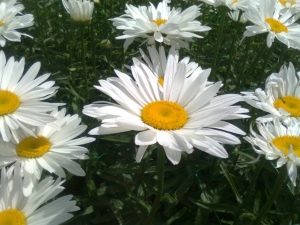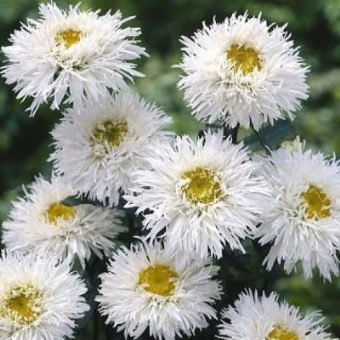When do the field and garden "daisies" bloom?

Many gardeners love to plant on their private plots simple and unpretentious snow-white chamomiles, called among summer residents, as "cute simplicity." In order for their flowering to delight you throughout the summer season, you need to know some simple rules of cultivation.
Brief description of the plant
Field chamomile or Common cornflower is a perennial plant of the Astrov family. Daisy chamomile was widely spread in Eurasia. Some varieties of cornflower are also found in North America and Australia. In our country it grows abundantly in all regions of Siberia, in the Crimea and in the Caucasus.
Thickets of wild chamomile can be found in forests, on slopes, often grows in vegetable gardens and on sown fields, like weeds.
This chamomile is distinguished by large white inflorescences on even and unbranched stems, the average height of which is 60 centimeters, but some individuals can reach almost a meter height. Straight stems grow from the rhizome, along with dark-green toothed leaves on both sides.
During the flowering period, flower stalks on the central axis are the first to bloom in daisies, after which the flowers on the lateral shoots bloom. Each bloom lasts from one week to ten days, but in nature there have been cases of flowering of one basket for three weeks.
Due to such uneven development of inflorescences and shoots, the flowering of one plant is prolonged for a period of one to two calendar months. As a result, the seed ripening periods are also extended over time.
For its bright decorative it is so loved by gardeners and landscape designers.
The period of flowering and growth varieties
About 70 varieties of field and garden camomiles are known.
Pharmacy Chamomile
Some of the daisies have healing properties. The most vivid example is familiar to everyone. pharmacy chamomile. In the conditions of Central Russia, the Volga region in June begins to bloom medicinal chamomile, and in early July, the first fruits ripen. Under the condition of a warm spring, flowering may begin in May, and in this case the plant will die off at the end of July.
Among the summer residents, the most popular are nivyaniki, known as decorative ones, although they also have some healing properties.
Nivyanik magnificent
Gingerbread magnificent - perennial with very large flowers, cups which reach up to 8 centimeters in diameter, and the height of the stem can be 90 centimeters. There are also undersized varieties, up to 30 centimeters high, some of them have terry inflorescences.
Nivyanik blooms magnificent in July - August. He is very fond of gardeners for their endurance and frost resistance - the root system of the plant is able to withstand frosts down to –29 ° C. So such a daisy is not terribly cold season.
Greater Nivyanik
It is also very popular with amateur gardeners, the largest of these, including a huge number of its hybrids. This ornamental plant has very beautiful buds resembling chrysanthemum.
This type of berry, including all its varieties, is characterized by a later flowering. In the middle zone of our country, abundant flowering can be expected not earlier than the beginning of July, but at the same time they delight gardeners and the longest flowering period, which ends only with the onset of frost. This is because new runs for this variety are formed throughout the season.
The downside is that continuous flowering quickly exhausts the vitality and makes the plant unstable to adverse conditions.
Daisy
Common common cereal is also popular - the well-known white garden chamomile, which is distinguished by its simplicity of cultivation and unpretentious care. Tall hybrids of this species of bolegrain are distinguished by large inflorescences, which gives the plant a special decorative effect.
Flowers bloom in late May or early June.The flowering period lasts just over a month, an average of 40 to 45 days.
Application in landscape design
There are no difficulties or peculiarities in breeding garden chamomiles. All varieties and hybrids of the Nivyanik are very unpretentious in their care and look perfect in a wide variety of plantings.
In the wild, chamomiles tend to grow in places well lit by the sun, so it is preferable to plant them in country houses on the sunny side.
It is advisable to plant chamomiles in chernozem, on sandy or loamy soils, the plant will most likely not take root.
It must be remembered that chamomiles need abundant watering, so the soil must be sufficiently permeable. At the same time, it is not possible to plant in places of abundant accumulation of melt water, since this may lead to rotting of the root system of a plant.
The main rule when creating a landscape design for your site: it is necessary to take into account the flowering period of each variety.
Another rule is to take into account the height of each individual species when disembarking.. For example, high varieties of cornfield will look great in a mass planting, along a fence or some small building.
Nivyanik generally very harmonious in any group landing. Dark abundant green leaves, covered with snow-white caps of inflorescences, looks like a solid elegant coverlet.
Perfectly Nivyanik will look in a mixed flower garden. It is ideally combined with various varieties of cornflowers and bluebells, as well as with delphinium.
Low-growing varieties of cornfield better planted for the design of borders.
See the next video for more details on how to grow a gardener in your garden.














































